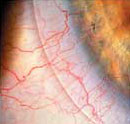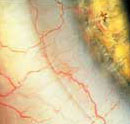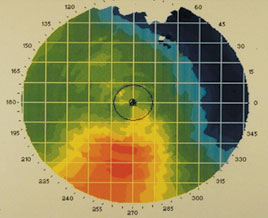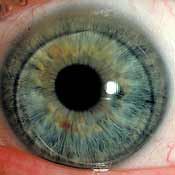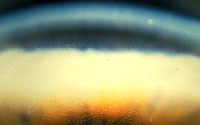Silicone hydrogels: not just for continuous wear anymore
With the introduction of new silicone hydrogels in spherical and toric — with the promise of a bifocal in the not-so-distant future, this raises the question: Why the seemingly new interest in oxygen? After all, haven’t our patients been doing just fine with disposable lenses and the easy-to-use one-bottle lens care regimens?
Inconveniences of soft lens wear
Many patients and eye care practitioners have simply accepted ocular redness, lens awareness or late-day dryness and visual changes as an accepted inconvenience of soft contact lens wear. When the need to prolong comfortable daily wear time and to reduce adverse signs becomes apparent, practitioners have traditionally relied on changing wear schedules, lens replacement frequency or care regimen. Unfortunately, these strategies have done little to reduce the number of contact lens dropouts each year.
The one critical aspect of soft contact lens wear that could not be easily addressed with traditional HEMA-based materials was oxygen permeability, and this can play a critical role in long-term contact lens success.
Oxygen deprivation syndrome
| |
|
|
| |
|
|
![Jennifer L. Smythe, OD, MS, FAAO [photo]](/~/media/images/news/print/primary-care-optometry-news/2005/04_april/smythe_70_90_75470.jpg)
Jennifer L. Smythe
Oxygen is required of all tissues in the body to produce energy for cell metabolism. In the cornea, the energy derived from aerobic respiration aids in cellular production, maintenance, repair and maturation. Prolonged oxygen deprivation and the subsequent hypoxic stress can alter corneal tissue. Clinically, the stress may manifest as corneal staining, limbal hyperemia, epithelial microcysts, endothelial polymegathism, corneal swelling, topography changes or refractive error shifts. These complications related to hypoxia and low-Dk lens materials occur more commonly in overnight wear, but are also observed in daily wear.
The syndrome related to long-term oxygen deprivation has also been described in the literature as corneal fatigue or corneal exhaustion. It is no surprise that the earliest references to a collective group of signs and symptoms related to hypoxia leading to “contact-lens burn-out” occurred with PMMA lenses. However, Pence described a similar phenomenon with low-Dk gas-permeable (GP) lens wear, and in 1992, Sweeney reported on corneal exhaustion syndrome with daily wear of soft contact lenses.
The messages are the same: inadequate oxygen permeability can lead to adverse clinical signs that ultimately make the patient symptomatic enough to warrant lens discontinuation.
Ideally, it makes sense to prescribe the healthiest materials possible for every patient to prevent any complications related to hypoxia and prolong comfortable wear time. With the addition of two new lenses in the silicone hydrogel market, this is now possible for many patients, and the economics of this technology have made them more appealing to the daily-wear patient. Currently available silicone hydrogels in the United States are described in the accompanying table.
Special indications
If oxygen permeability is important for maintaining cellular function in the daily wear of contact lenses on a normal cornea, it is even more critical for the physiologically compromised or physically irregular eye. Silicone hydrogels should be the material of choice for all initial bandage contact lens indications or as the soft lens base for piggyback fitting.
Bandage contact lenses serve several purposes, including acting as a pressure patch for the provision of pain relief and corneal protection as well serving as a reservoir for intraocular drug delivery. This therapeutic use of a contact lens is beneficial for promoting healing postoperatively, after trauma or when the cornea is in danger of further debridement, such as during the re-epithelialization process of recurrent corneal erosion.
The system of a GP contact lens worn over a soft lens on the same eye (a piggyback fit) is a viable option for problem-solving lens decentration, maintaining corneal epithelial integrity and enhancing patient comfort. A multitude of indications exist for the piggyback technique for both the regular and irregular cornea. They include keratoconus, post-refractive surgery, post-penetrating keratoplasty, post-trauma and any time lens centration is difficult or epithelial integrity is compromised from a GP lens.
Fitting a piggyback lens
| |
|
Fitting can be as simple as placing the silicone hydrogel on the eye and then performing keratometry or topography over the top of the soft lens to determine the appropriate base curve for the GP lens. Consider selecting a silicone hydrogel lens with low plus or even high plus power for an oblate surface topography, with the goal of emulating the prolate shape of a normal cornea.
A GP lens with a posterior radius of curvature equal to flat-K or the position 3 mm temporal from center on a topography map and an overall diameter of 9.0 to 9.5 mm is an excellent starting point. In some instances, the habitual GP lens may be used over the silicone hydrogel without redesigning the parameters.
Choices for dry eye
Finally, the superior oxygen permeability and reduced on-eye lens dehydration make silicone hydrogels the material of choice for diabetic patients or individuals with true dry eye. The lack of a vascular response with high-Dk lenses reduces the risks associated with contact lens wear in diabetes, and in a dry eye patient, a silicone hydrogel may have a therapeutic benefit by acting as a bandage and providing protection against further corneal desiccation.
Choices for therapeutic use
In May 2003, Focus Night & Day (CIBA Vision) received Food and Drug Administration approval for “therapeutic use.” Therefore, it is often selected initially for special applications.
In instances where an appropriate fit is not obtained or when Focus Night & Day fails secondary to other issues such as discomfort, it is prudent to consider “off-label” use of the other commercially available silicone hydrogels. The larger overall diameter of O2 Optix (CIBA) may be needed to provide complete corneal coverage, or the lower modulus of both O2 Optix and Acuvue Advance (Vistakon) may be necessary if comfort is not acceptable with Focus Night & Day.
Refitting from low Dk
|
|
|
It is not uncommon to suddenly see an initial exacerbation of adverse symptomatology immediately after refitting a patient from low-Dk lenses into high-Dk materials. This is very similar to the phenomenon observed in the past when PMMA wearers were fit with GP lenses. Hypoesthesia of the cornea lessens, cellular metabolism begins to function at a normal rate or initially may speed up in the presence of oxygen, and a hyperopic shift in refractive error can occur. These physiologic changes may cause mild lens awareness and visual acuity fluctuations.
Additionally, the higher modulus of elasticity of both Focus Night & Day and PureVision (Bausch & Lomb) may physically cause slight initial lens awareness. All of these concerns can be easily managed with proper patient education starting at the initial fitting visit. Letting the patient know the benefits of high-Dk materials and some of the common changes that may occur with adaptation from the beginning makes the transition to these superior materials smoother.
Lens care
One of the biggest differences between continuous wear and daily wear is the lens care. Shortly after the introduction of silicone hydrogels in the marketplace, both anecdotal and documented reports of lens:solution incompatibilities surfaced. These reports led to confusion in the industry and the concern that PHMB-preserved products should not be used with silicone hydrogels due to corneal staining. The reality is that the role of this preservative in causing corneal staining has been oversimplified, and some PHMB-preserved products create as little staining as peroxide- or Polyquad-based regimens.
The greatest incidence of epithelial disruption occurred with the use of ReNu MultiPlus (Bausch & Lomb) with PureVision lenses (Jones L, Macdougall N, Sorbara L. Optom Vis Sci. 2002;79:753-761). With the reformulation of many popular multipurpose lens care regimens (including ReNu), there are no reported adverse interactions between the available silicone hydrogels and any lens care product currently on the U.S. market.
Both OptiFree (Alcon) and ClearCare (CIBA Vision) have FDA approval for use with silicone hydrogels, and the newest regimen, Aquify (CIBA Vision), was specifically formulated for use with silicone hydrogel lenses.
|
Currently Available Silicone Hydrogels |
|||||
| PureVision* | Focus Night & Day | Acuvue Advance | Acuvue Advance for Astigmatism |
O2Optix | |
| Material | Balafilcon A | Lotrafilcon A | Galyficon A | Galyfilcon A | Lotrafilcon B |
| Dk/t | 110 (non edge corrected) | 175 | 85.7 | 85 | 138 |
| Water content | 36% | 24% | 47% | 47% | 33% |
| Base curve(s) | 8.6 mm | 8.4 mm and 8.6 mm | 8.3 mm and 8.7 mm | 8.6 mm | 8.6 mm |
| Diameter | 14.0 mm | 13.8 mm | 14.0 mm | 14.5 mm | 14.2 mm |
| Power | +6 D to –12 D | +6 D to –10 D in 0.25-D steps; –8 D to –10 D in 0.50-D steps |
+8 D to –12 D | See below** | –1 D to –6 D |
| Modality | Daily wear & up to 30 nights CW | Up to 30 nights CW | 2-week DW | 2-week DW | 2-week DW or 6 night EW |
|
*PureVision will be reintroduced into the U.S. market in April **Acuvue Advance for Astigmatism is available in minus sphere and three cylinder powers in limited axes, but will be available in all of the following powers by the end of June: plano to –6 D in 0.25-D steps with cylinders –0.75, -1.25, -1.75, axis: 10 to 180 in 10-degree steps; -6.50 D to –9 D in 0.50-D steps with cylinders –1.25, -1.75, axis: 90 and 180 +/-20 (no obliques); +0.25 to +6 D in 0.25-D steps with cylinders –0.75, -1.25, -1.75, axis: 90 and 180 +/-20 (no obliques). |
|||||

